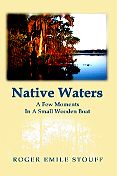|
Hurricane Rita wrecked the freshwater fishing here. My
usual haunts have been completely unproductive and lack
of rain has only worsened the situation.
Instead, I have been venturing far afield in search of
more productive water this year. If things play out the
way they did after Hurricane Andrew cut through here,
it'll be three years before any decent fishing returns.
But Andrew cut a 200-mile-wide path with 200-mile-per-hour
winds right where I'm sitting today. Rita made landfall
150 miles from here, but her storm surge inundated my
freshwater fishing locales with saltwater. Baitfish
succumbed and I while I didn't see huge rafts of dead
fish like after Andrew, their absence verifies their
demise. Reports from most of the coastal parishes are
the same. Saltwater is kicking tail, however, I'm just
not set up for that kind of fishing and nobody's invited
me lately!
That's not to say that there aren't a few spots that
produce a few freshwater fish, but it's hit and miss,
as if the fish are roaming heavily in search of food.
A couple weeks ago I decided to make an exploratory
trip in my bass boat for an area south of here known
locally as Quintana.
It was too far for me to paddle the pinou. Quintana is
a series of oilfield canals cut into the coastal marshes.
I reasoned that brackish water bass and panfish might have
had a higher resistance to the salt than my exclusively
freshwater quarry in other areas. I have a map of Quintana
from a friend and, bracing my resolve, I put the boat over
into the Franklin Canal.
The map illustrates the Quintana area very well, but what
it does not show is how to get there. I knew that one had
to turn into the Hanson Canal from the Franklin Canal,
which I did, but then I got to a three-way intersection.
I was confused and unsure of myself. I idled forward and
grounded out in the middle fork. I backed the boat out and
went right, and grounded out again. I backed out and went
left and found ample water so throttled up to travel about
two miles before I chickened out and turned back, making my
way back to the Hanson and Franklin Canal intersections. I
got on my cell phone and called a friend and he told me I
had nearly gotten to Quintana but turned around too soon.
However, he directed me to another area that was easier to
find, but I had to cut through two miles of water lily
accumulations. It wasn't water hyacinth, if was something
we call "silver dollar" down here, a thick, matted plant
that floats in great rafts. I had to stop several times to
clear tons of this that accumulated between my outboard
and transom, but finally got to a spot where the canal
widened out and seemed promising.
I had with me a #5 Redington at eight foot. I don't fish
anything lighter in these waters. I never know what I'll
hook, big bass, monster catfish or bowfin, garfish. I know
lots of folks who fish bluegill and the like with #4 down
to #2 lines down here, but I just don't care for it. With
a minimum #5, I feel I've got enough backbone to fight the
unexpected and still don't feel over-gunned for panfish.
My fly of choice was the cap spider. You can find this pattern
on www.laflyfish.com if you don't know it. It's tied on a micro
jig head so that the hook rides up, is very "leggy" and great
for getting down there to larger, deeper fish. I had only two
chartreuse cap spiders with a red spot at the head, and two
blacks with a red spot at the head. I fished these under an
indicator.
The very first cast saw the indicator - which we here in south
Louisiana call a VOSI, or Vertically Oriented Strike Indicator
as so dubbed by Glen Cormier, LaFlyFish's webmaster - settle
in for a split second then plunge out of view. I lifted the
rod tip and something yanked back, a side-slabbing, furious
red-breasted 'gill big as my hand.
"Fluke," I thought to myself. "Can't be."
I let the big fella go and cast back to the same spot. I could
see there was a huge stump remnant just under the surface of
the water. No sooner had the VOSI hit the surface than it
darted away and within moments a thrashing, frantic and very
angry orange slab came to hand.
"Hmm," I thought. "Maybe not."
This fish went to the livewell. Another cast produced the
last member of the triplets and I got disheartened. I moved
the boat up a little and, for the next two hours, spot-cast
and spot-caught, so to speak. Ended up with 16 in the box,
all beauties except one that I hooked too deeply to release
conscientiously. I caught probably twice that many.
When it got too hot to bear I made my way home. It was the
first good trip I had made all spring, and though that water
was largely fresh it alternates with brackish throughout the
year, so perhaps my theory on salt tolerance holds some merit.
I have not been back to test it.
I'm estimating an 80 percent reduction in freshwater fisheries
along the coastal parishes this spring by what I've been reading
from other fishermen and reports in newspapers. Catches will
probably continue to be spotty and roaming, as I believe these
fish were also foraging for food or, at best, isolated enough
and salt-tolerant enough to be a pocket of survival.
The first named hurricane of the year was supposed to hit
Florida last week, luckily it turned out to be a 'tropical
storm.' We along the Gulf Coast are all in need of your
prayers. ~ Roger
 Do you have your copy yet? It's out! And available now! Get your
copy of Roger's book. Native Waters: A Few Moments in a Small Wooden Boat
Do you have your copy yet? It's out! And available now! Get your
copy of Roger's book. Native Waters: A Few Moments in a Small Wooden Boat
Order it now from
www.iuniverse.com, Amazon.com,
or Barnes & Noble.com.
|


 Do you have your copy yet? It's out! And available now! Get your
copy of Roger's book. Native Waters: A Few Moments in a Small Wooden Boat
Do you have your copy yet? It's out! And available now! Get your
copy of Roger's book. Native Waters: A Few Moments in a Small Wooden Boat